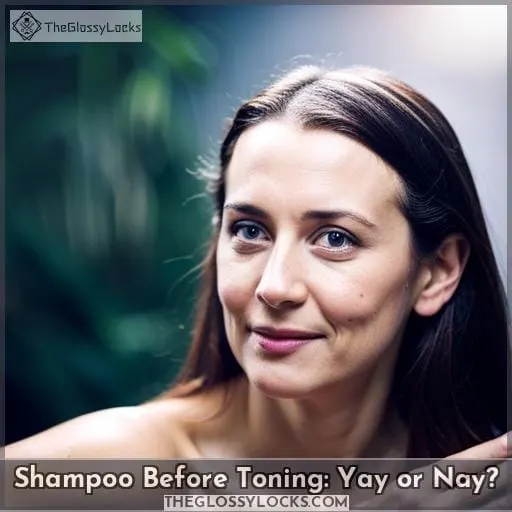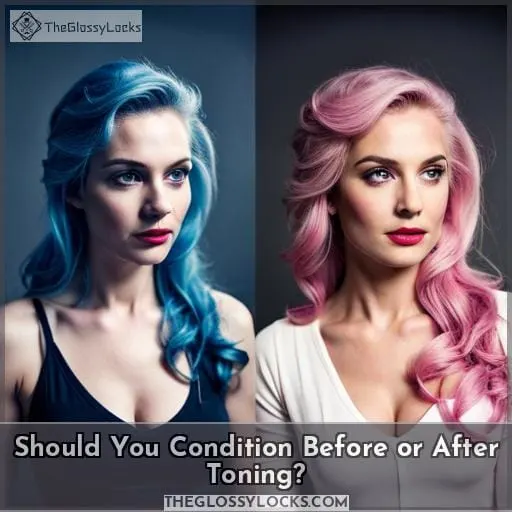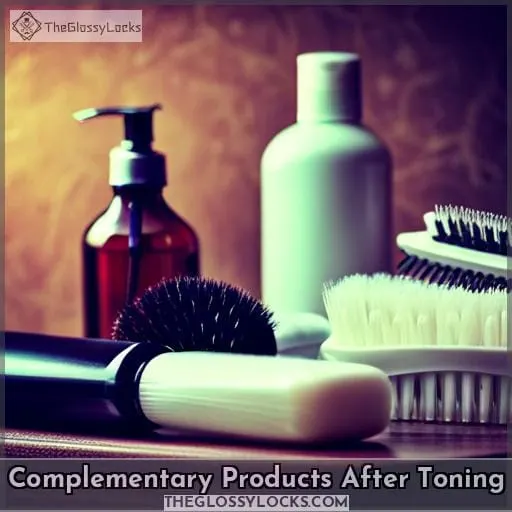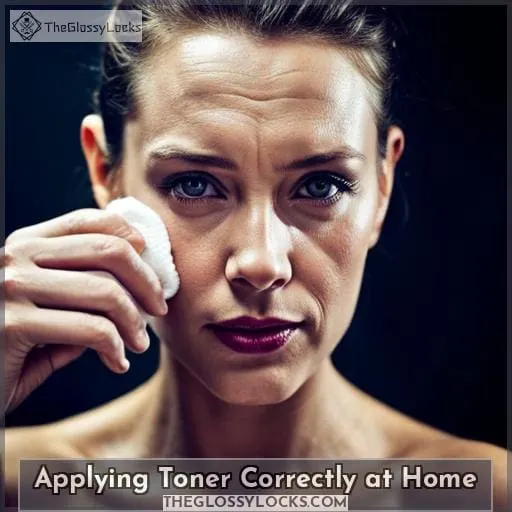This site is supported by our readers. We may earn a commission, at no cost to you, if you purchase through links.
 If your hair is still orange and brassy after bleaching, hold off on that pale toner. With too dark of a base, those whitish hues simply lack the strength to truly shift your shade.
If your hair is still orange and brassy after bleaching, hold off on that pale toner. With too dark of a base, those whitish hues simply lack the strength to truly shift your shade.
Instead, embrace the chance to care for those delicate strands. Cloak them in conditioning, nourish with a mask, then revisit toning once lifted to a lemony blonde.
Table Of Contents
Key Takeaways
- Toner should be applied before conditioning.
- Pre-toning conditioning helps the toner penetrate evenly.
- Purple shampoo should be used weekly after toning to maintain the toner color.
- Applying a hydrating hair mask or intensive treatment after toning helps seal in moisture and maximize shine.
Shampoo Before Toning: Yay or Nay?

When preparing to tone hair, you may be wondering if you should shampoo first – but we recommend skipping it.
Shampooing strips the hair and scalp of protective natural oils, potentially irritating the scalp and interfering with toner results.
Retaining those oils aids toner development, protecting your scalp and hair for better color depositing.
Protecting Scalp and Hair Before Toning
Yay or Nay? You’ll want to skip shampooing before applying toner to retain the scalp’s natural oils that protect hair and skin.
- Scalp Protection
- Hair Shielding
- Toner Prep
- Pre-Color Care
Skipping shampoo keeps the scalp’s natural oils intact to act as a protectant barrier before toner application. This guards the scalp and hair, allowing better toner absorption while minimizing irritation.
Skipping Shampoo to Retain Natural Oils
By skipping shampoo before toning, you’ll retain your hair’s natural oils that protect your scalp and aid the toner in settling correctly.
The scalp’s natural sebum nourishes hair, sealing in moisture that keeps strands strong and shiny. Shampooing pre-toner removes these beneficial oils, leaving hair dry and exposed.
Toner develops optimally on hair with balanced hydration since the cuticle lies flat, allowing deeper pigment penetration. Retaining natural oils also prevents possible scalp irritation from toner ingredients.
Ultimately, skipping shampoo retains moisture and oils critical for healthy, efficient toner application.
Should You Condition Before or After Toning?
You may have heard that conditioner should always come after toning, but this rule is a myth. Pre-toning conditioning actually helps the toner penetrate evenly, while making application less painful by easing knots.
Let’s unpack why conditioning first aids toner results and comfort.
No Conditioner Before Toning Myth
Although the traditional advice is to avoid conditioner before toning to prevent interference, using conditioner beforehand actually provides multiple benefits during the process.
Conditioning science reveals cuticle closure is a myth; conditioner acts as an equalizer, allowing even toner distribution for optimal results.
Pre-toning conditioning enables effortless detangling and client comfort while also boosting retail strategies through personalized aftercare regimens.
This tailored approach enhances client satisfaction by connecting specific hair products to individual needs and the toning process.
Benefits of Pre-Toning Conditioner
Before toning your hair, you may wonder if conditioning before or after the process will yield the best results.
- Scalp Protection: Pre-toning conditioner creates a barrier between the toner and your scalp, preventing any potential irritation.
- Natural Oil Retention: Conditioner helps retain natural oils on your scalp, ensuring it remains healthy and moisturized during the toning process.
- Myth Debunking: Contrary to popular belief, using conditioner before toning doesn’t interfere with color deposition but actually promotes even color distribution.
- Customized Regimens: Incorporating pre-toning conditioning allows for personalized and tailored regimens based on individual hair needs.
These are just a few of the advantages that come from using conditioner prior to applying toner.
Complementary Products After Toning
After you apply toner, consider adding other products to maintain and enhance the results.
To preserve toner color, use a purple shampoo weekly.
For added nourishment, apply a hydrating hair mask or intensive treatment to seal in moisture and maximize shine.
Purple Shampoo to Maintain Effects
Since a toner’s effects tend to fade over time, you’ll want to use a purple shampoo weekly after toning to maintain the neutralized brassiness. Consider incorporating a purple shampoo or conditioner into your routine to keep your hair free of yellow tones between salon visits.
| Hair Color | Frequency | Products |
|---|---|---|
| Blonde | 1-2 times per week | Fanola No Yellow Shampoo, Clairol Shimmer Lights |
| Brown | Once every 2 weeks | Joico Color Balance Blue Shampoo, Bold Uniq Purple Conditioner |
| Color Treated | 1-2 times per week | Pravana The Perfect Blonde Shampoo, Overtone Purple Conditioner |
The purple pigments in these shampoos cling to hair strands, counteracting brassiness. Used too often, however, some formulas may result in over-toning. Find the right balance for your hair color and needs.
Masks and Treatments for Optimal Results
One mask or treatment you should consider post-toning is a reconstructing mask, which helps seal in color while restoring hair structure.
- Apply a weekly deep conditioning hair mask for 10-15 minutes. This nourishes hair, sealing in toner pigments.
- Use a clear hair gloss monthly to smooth and seal the cuticle, locking in color.
- Incorporate a heat protectant spray before heat styling. This shields strands from damage while allowing toners to take hold.
- Try a lightweight hair oil, like argan, coconut, or marula daily. Oils reinforce tone while delivering vital hydration.
Creating an Ideal Experience for Clients
To create an ideal experience for your clients, it’s essential to provide a customized post-salon care regimen tailored to their specific hair needs.
By understanding each client’s unique requirements, you can make personalized recommendations for products that will enhance their results and maintain the longevity of their toner.
This attention to detail not only increases client satisfaction but also presents opportunities to boost retail sales by offering tailored solutions for at-home care.
Customized Post-Salon Care Regimen
When formulating aftercare plans, you’d serve clients well by creating personalized product recommendations tailored to their unique hair needs and styling goals.
Consider products that enhance client comfort by easing stress and pain during brushing and detangling.
Recommend masks for optimally sealing in toner color based on hair porosity.
Connecting prescribed home care to what clients experience during toning and teasylighting boosts retail sales while ensuring excellent service.
Tailored Recommendations for Hair Needs
After creating a customized post-salon care regimen for clients, you’d tailor specific product recommendations to meet individual hair needs for an ideal experience.
- Assess hair porosity and damage to select targeted treatments.
- Consider recent processing when advising on toner timing.
- Connect clients with compatible toners and purple shampoos for their color-treated hair.
Applying Toner Correctly at Home
When applying toner at home, it’s important to:
- Target the areas that need color correction.
- Conduct a strand test before applying the toner to ensure desired results.
- Monitor development time closely.
By following these steps, you can achieve optimal results when using toner at home.
Targeting Areas Needing Color Correction
Before applying toner at home, you’ll want to:
- Wash your hair without shampoo.
- Check to see which areas need color correction.
- Target the toner specifically on those spots.
Focus on the roots and ends as well as the back and sides of your hair. If you have dry or damaged hair, pay extra attention to these areas for optimal results. Additionally, if you have porous or coarse blonde hair that tends to become brassy easily, targeting those specific sections will help correct any splotchy toner issues.
Make sure to use high-quality toning products designed for color correction in highlighted hair.
Testing Toner and Monitoring Development Time
You should conduct a strand test, particularly when toning for the first time, and keep track of the time the toner has been developing to determine the ideal duration based on your hair’s level of porosity.
More porous hair may require less time, while 5-15 minutes is typical.
Adjust developer strength and pre-tone washing to minimize scalp irritation.
Carefully apply toner only where color correction is needed, monitoring changes until the desired tone is reached.
Development time, test strands, and targeted application allow better toner results.
Frequently Asked Questions (FAQs)
How often should I tone my hair at home?
To maintain your desired hair color, tone it at home every 4-6 weeks. Adjust the frequency based on how often you wash your hair.
What happens if I leave the toner on too long?
Overprocessing with toner can lead to hair damage.
It’s best to follow instructions and not leave toner on too long.
Can I tone my hair right after coloring it?
Yes, you can apply toner immediately after coloring for optimal results.
Focus application on areas prone to brassiness.
Allow the toner to process for 10-20 minutes, adjusting time based on hair porosity.
Rinse thoroughly before conditioning.
What’s the difference between a toner and a dye?
A toner deposits color to tone and enhance hair hue while a dye permeates the hair cuticle to permanently alter pigment and lift color.
Toners refine shade and reduce brassiness but don’t dramatically lighten.
Is it okay to tone over previously toned hair?
Yes, it’s fine to tone over previously toned hair.
When applied correctly, the new toner pigments can penetrate the hair shaft and override the existing tone.
It’s best to avoid overprocessing though.
Do a strand test and watch development closely when applying toner over hair that’s been recently toned.
Conclusion
So my artificially colored friend, have we learned our lesson? Respect those fragile strands before and after toning by conditioning properly. Cloak them in salon nourishment with customized regimens. Then when you’ve prepped the canvas, creative colorful makeovers can commence – as you tone those tresses to perfection while still using conditioner for best results.







